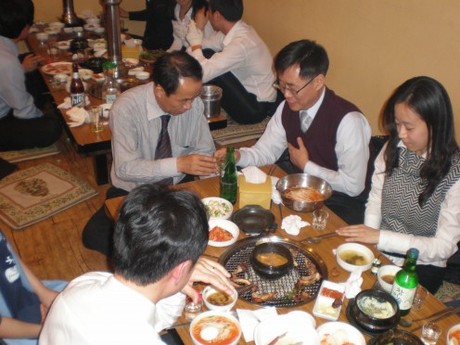
Dining etiquette
Dining etiquette in Korea can be traced back to the Confucian philosophies of the Joseon period. Guidebooks, such as Sasojeol (士小節, Elementary Etiquette for Scholar Families), written in 1775 by Yi Deokmu (李德懋), comment on the dining etiquette for the period. Suggestions include items such as "when you see a fat cow, goat, pig, or chicken, do not immediately speak of slaughtering, cooking or eating it", "when you are having a meal with others, do not speak of smelly or dirty things, such as boils or diarrhea," "when eating a meal, neither eat so slowly as to appear to be eating against your will nor so fast as if to be taking someone else's food. Do not throw chopsticks on the table. Spoons should not touch plates, making a clashing sound" amongst many other recommendations which emphasized proper table etiquette.
The eldest male at the table was always served first, commonly served to them in the men's quarters by the women of the house. Women usually dined in a separate portion of the house after the men were served. The eldest men or women always ate before the younger family members. The meal was usually quiet, as conversation was discouraged during meals. In modern times, these rules have become lax, as families usually dine together now and use the time to converse. Of the remaining elements of this decorum, one is that the younger members of the table should not pick up their chopsticks or start eating before the elders of the table.
In Korea, unlike in China and Japan, the rice bowl is not lifted from the table when eating from it. This is due to the fact that each diner is given a metal spoon along with the chopsticks known collectively as sujeo. The use of the spoon for eating rice and soups is expected. There are rules which reflect the decorum of sharing communal side dishes; rules include not picking through the dishes for certain items while leaving others, and the spoon used should be clean, because usually diners put their spoons in the same serving bowl on the table. Diners should also cover their mouths when using a toothpick after the meal.
The table setup is important as well, and individual place settings, moving from the diner's left should be as follows: rice bowl, spoon, then chopsticks. Hot foods are set to the right side of the table, with the cold foods to the left. Soup must remain on the right side of the diner along with stews. Vegetables remain on the left along with the rice, and kimchi is set to the back while sauces remain in the front.
Korean chopsticks made of silver.
Drinking etiquette
The manner of drinking alcoholic drinks at dining is particularly important in Korean dining etiquette. Each diner is expected to face away from the eldest male and cover his mouth when drinking alcohol. In the most formal situations, when the eldest male offers a drink, the diner should politely refuse it three times. After three refusals, when the eldest male offers one more time, then finally the diner can receive it.

Log in to write a comment